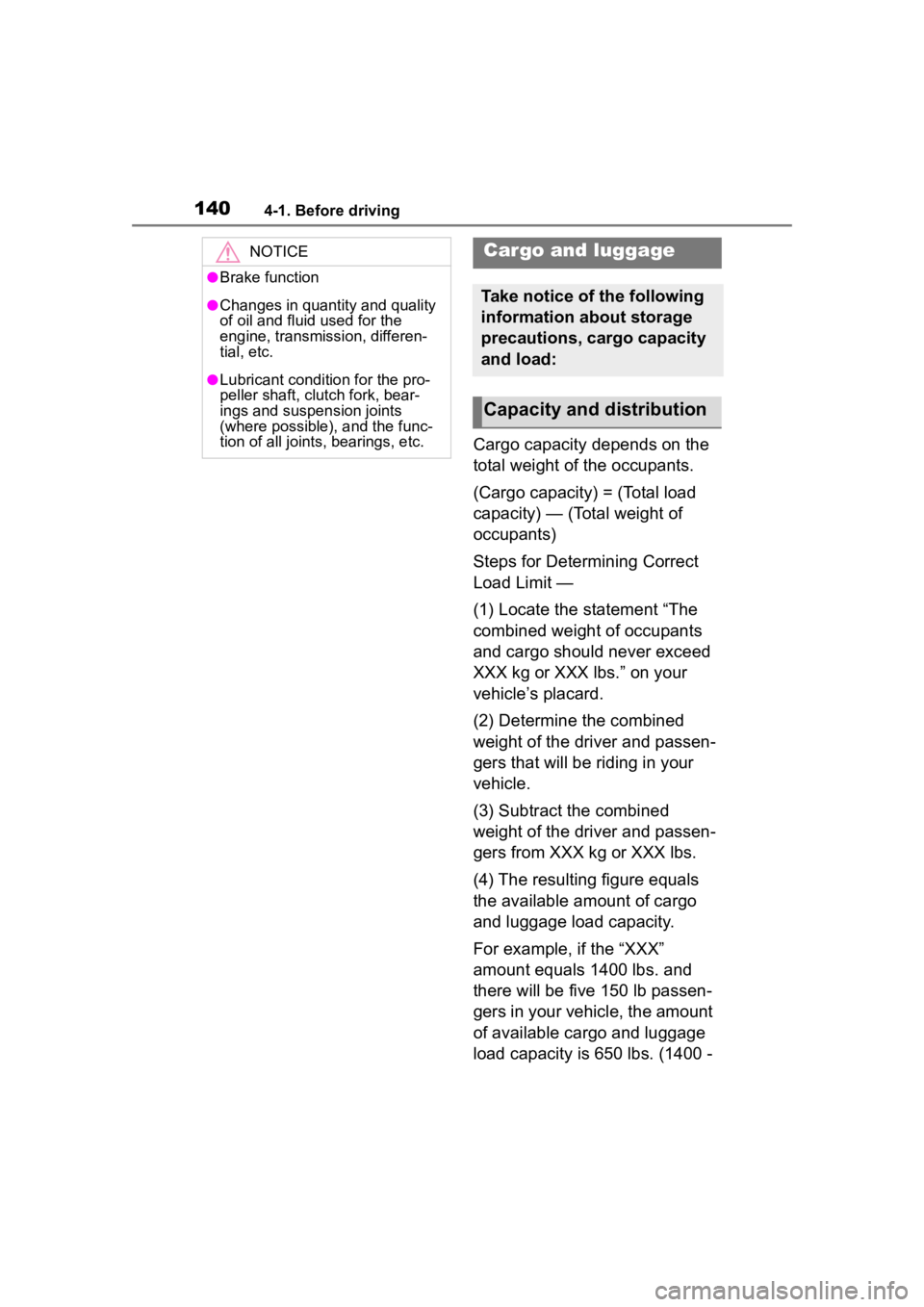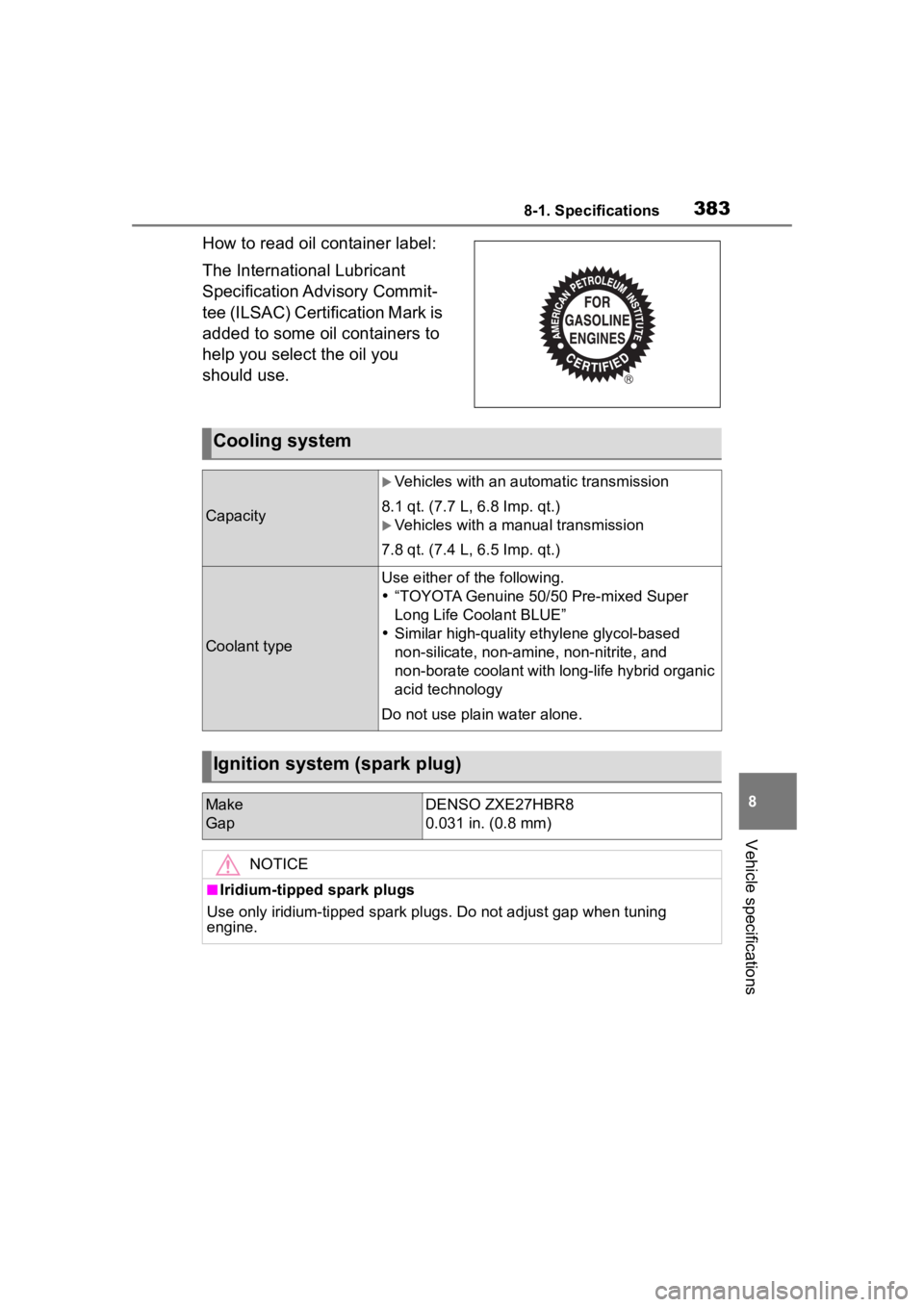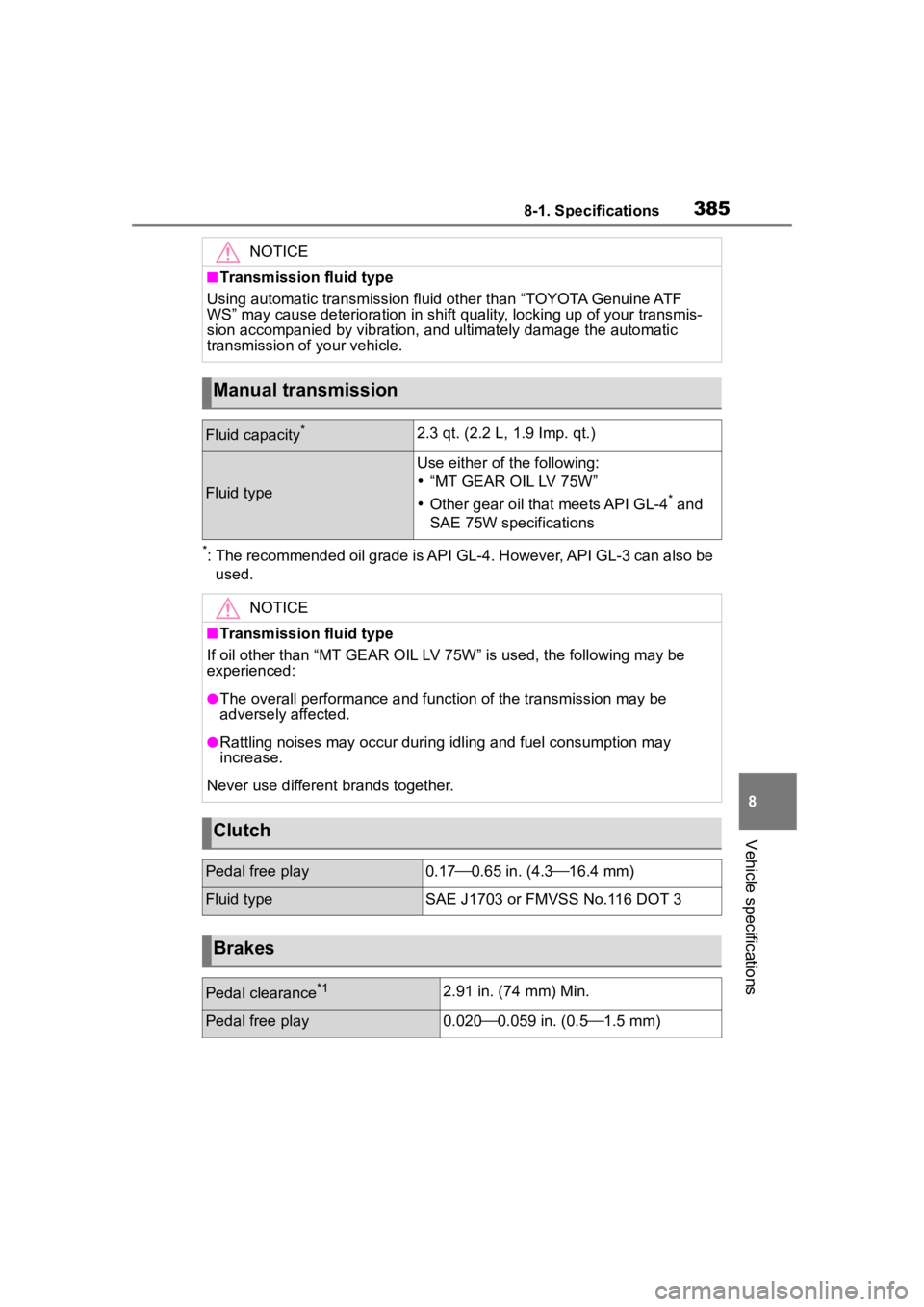2023 TOYOTA 86 oil capacity
[x] Cancel search: oil capacityPage 13 of 449

13Pictorial index
Refueling method ................................................................. P.167
Fuel type/fuel tan k capacity ................................... .............. P.381
Tires.......................................................... ........................... P.312
Tire size/inflation pressure ................................... ................ P.386
Winter tires/tire chain ........................................ ................... P.266
Checking/rotation/tire pressur e warning system ..................P.312
Coping with flat tires......................................... .................... P.358
Hood ........................................................... ......................... P.302
Opening ............................................................................... P.302
Engine oil ..................................................... ........................ P.382
Coping with overheating ...................................................... P.375
Warning messages ............................................... ............... P.357
Headlights..................................................... ...................... P.158
Parking lights/dayt ime running lights .......................... .... P.158
Turn signal lights ............................................. .................. P.155
Side marker lights ............................................. ................. P.158
Stop lights/tail light s/side marker lights/
turn signal lights ........................................................ P.155, 158
License plate lights........................................... ................. P.158
Back up light
Shifting the shift lever to R ........................................... P.150, 153
Light bulbs of the exterior lights for driving
(Replacing method: P.333, Watts: P.387)
Page 140 of 449

1404-1. Before driving
Cargo capacity depends on the
total weight of the occupants.
(Cargo capacity) = (Total load
capacity) — (Total weight of
occupants)
Steps for Determining Correct
Load Limit —
(1) Locate the statement “The
combined weight of occupants
and cargo should never exceed
XXX kg or XXX lbs.” on your
vehicle’s placard.
(2) Determine the combined
weight of the driver and passen-
gers that will be riding in your
vehicle.
(3) Subtract the combined
weight of the driver and passen-
gers from XXX kg or XXX lbs.
(4) The resulting figure equals
the available amount of cargo
and luggage load capacity.
For example, if the “XXX”
amount equals 1400 lbs. and
there will be five 150 lb passen-
gers in your vehicle, the amount
of available cargo and luggage
load capacity is 650 lbs. (1400 -
NOTICE
●Brake function
●Changes in quantity and quality
of oil and fluid used for the
engine, transmission, differen-
tial, etc.
●Lubricant condition for the pro-
peller shaft, clutch fork, bear-
ings and suspension joints
(where possible), and the func-
tion of all joints, bearings, etc.
Cargo and luggage
Take notice of the following
information about storage
precautions, cargo capacity
and load:
Capacity and distribution
Page 380 of 449

3808-1. Specifications
8-1.Specifications
*: Unladen vehicle
■Vehicle identification num-
ber
The vehicle identification num-
ber (VIN) is the legal identifier
for your vehicle. This is the pri-
mary identification number for
your Toyota. It is used in regis-
tering the ownership of your
vehicle.
This number is stamped under
the right-hand front seat. This number is located on the
top left of the body panel.
Maintenance data (fuel, oil level, etc.)
Dimensions and weight
Overall length167.9 in. (4265 mm)
Overall width69.9 in. (1775 mm)
Overall height*51.6 in. (1310 mm)
Wheelbase101.4 in. (2575 mm)
TreadFront59.8 in. (1520 mm)
Rear61.0 in. (1550 mm)
Vehicle capacity weight (Occupants + lug-
gage)Details are described on the
tire and loading information
label. (
P.323)
Seating capacity
Seating capacity4 (Front 2, Rear 2)
Vehicle identification
Page 382 of 449
![TOYOTA 86 2023 Owners Manual 3828-1. Specifications
unleaded gasoline with an octane rating of 91 (95 RON) may be used
with no detri ment to engine durab ility or driveability.
■Oil capacity (Drain and refill [Reference*])
*: TOYOTA 86 2023 Owners Manual 3828-1. Specifications
unleaded gasoline with an octane rating of 91 (95 RON) may be used
with no detri ment to engine durab ility or driveability.
■Oil capacity (Drain and refill [Reference*])
*:](/manual-img/14/59239/w960_59239-381.png)
3828-1. Specifications
unleaded gasoline with an octane rating of 91 (95 RON) may be used
with no detri ment to engine durab ility or driveability.
■Oil capacity (Drain and refill [Reference*])
*: The engine oil capacity is a reference quantity to be used whe n changing
the engine oil. Warm up and turn off the engine, wait more than 5 min-
utes, and check the oil level on the dipstick.
■Engine oil selection
“Toyota Genuine Motor Oil” is
used in your Toyota vehicle. Use
Toyota approved “Toyota Genu-
ine Motor Oil” or equivalent to
satisfy the following grade and
viscosity.
Oil grade: ILSAC GF-6A multi-
grade engine oil
Recommended viscosity: SAE
0W-20
SAE 0W-20 is the best choice
for good fuel economy and good
starting in cold weather.
If SAE 0W-20 is not available,
SAE 5W-20 oil may be used.
However, it must be replaced
with SAE 0W-20 at the next oil
change. Outside temperature
Oil viscosity (0W-20 is explained
here as an example):
• The 0W in 0W-20 indicates the characteristic of the oil
which allows cold startability.
Oils with a lower value before
the W allow for easier starting
of the engine in cold weather.
• The 20 in 0W-20 indicates the viscosity characteristic of the
oil when the oil is at high tem-
perature. An oil with a higher
viscosity (one with a higher
value) may be better suited if
the vehicle is operated at high
speeds, or under extreme
load conditions.
Lubrication system
With filter5.3 qt. (5.0 L , 4.4 Imp. qt.)
Without filter5.1 qt. (4.8 L, 4.2 Imp. qt.)
A
Page 383 of 449

3838-1. Specifications
8
Vehicle specifications
How to read oil container label:
The International Lubricant
Specification Advisory Commit-
tee (ILSAC) Certification Mark is
added to some oil containers to
help you select the oil you
should use.
Cooling system
Capacity
Vehicles with an automatic transmission
8.1 qt. (7.7 L, 6.8 Imp. qt.)
Vehicles with a manual transmission
7.8 qt. (7.4 L, 6.5 Imp. qt.)
Coolant type
Use either o f the following.
“TOYOTA Genuine 50/50 Pre-mixed Super
Long Life Coolant BLUE”
Similar high-quality et hylene glycol-based
non-silicate, non -amine, non-nitrite, and
non-borate coolant with long-life hybrid organic
acid technology
Do not use pla in water alone.
Ignition system (spark plug)
Make
GapDENSO ZXE27HBR8
0.031 in. (0.8 mm)
NOTICE
■Iridium-tipped spark plugs
Use only iridium-tipped spark pl ugs. Do not adjust gap when tun ing
engine.
Page 384 of 449

3848-1. Specifications
*: Your Toyota vehicle is filled with “Toyota Genuine Differential Gear Oil LX”
at the factory. Use Toyota approved “Toyota Genuine Differentia l Gear Oil
LX” or an equivalent of matching quality to satisfy the above s pecification.
Please contact your Toyota dealer for further details.
*: The fluid capacity is p rovided as a reference.
If replacement is necessary, contact your Toyota dealer.
Electrical system
Battery
Specific gravity reading at 68°F
(20°C):1.2501.290 Fully charged
1.1601.200 Half charged
1.0601.100 Discharged
Charging rates
Quick charge
Slow charge
15 A max.
5 A max.
Differential
Oil capacity (Reference)1.22 qt. (1.15 L, 1.01 Imp. qt.)
Oil type and viscosity* Toyota Genuine Differential Gear Oil LX
Other LSD gear oil that meets API GL-5
and SAE 75W-85
NOTICE
■Differential gear oil type
Using a differential gear oil ot her than “Toyota Genuine Differ ential Gear
Oil LX” may cause occurrences of noises, vibrations and poor fuel con-
sumption. Never use different brands together.
Automatic transmission
Fluid capacity*7.9 qt. (7.5 L, 6.6 Imp. qt.)
Fluid typeToyota Genuine ATF WS
Page 385 of 449

3858-1. Specifications
8
Vehicle specifications
*: The recommended oil grade is API GL-4. However, API GL-3 can also be
used.
NOTICE
■Transmission fluid type
Using automatic transmission fluid other than “TOYOTA Genuine A TF
WS” may cause deterioration in shift quality, locking up of your transmis-
sion accompanied by vibration, a nd ultimately damage the automatic
transmission of your vehicle.
Manual transmission
Fluid capacity*2.3 qt. (2.2 L, 1.9 Imp. qt.)
Fluid type
Use either of the following:
“MT GEAR OIL LV 75W”
Other gear oil that meets API GL-4
* and
SAE 75W specifications
NOTICE
■Transmission fluid type
If oil other than “MT GEAR OIL LV 75W” is used, the following m ay be
experienced:
●The overall performance and function of the transmission may be
adversely affected.
●Rattling noises may occur during idling and fuel consumption may
increase.
Never use different brands together.
Clutch
Pedal free play0.17 0.65 in. (4.3 16.4 mm)
Fluid typeSAE J1703 or FMVSS No.116 DOT 3
Brakes
Pedal clearance*12.91 in. (74 mm) Min.
Pedal free play0.0200.059 in. (0.51.5 mm)
Page 394 of 449

3948-1. Specifications
Recommended inflation pres-
sureCold tire inflation pressure recommended
by a manufacturer
Accessory weight
The combined weight (in excess of those
standard items which may be replaced) of
automatic transmission, power steering,
power brakes, power windows, power
seats, radio and heater, to the extent that
these items are available as fac-
tory-installed equipment (whether installed
or not)
Curb weight
The weight of a motor vehicle with stan-
dard equipment, including the maximum
capacity of fuel, oil and coolant, and if so
equipped, air conditioning and additional
weight optional engine
Maximum loaded vehicle
weight
The sum of:
(a) Curb weight
(b) Accessory weight
(c) Vehicle capacity weight
(d) Production options weight
Normal occupant weight
150 lb. (68 kg) times the number of occu-
pants specified in the second column of
Table 1
* that follows
Occupant distribution
Distribution of occupan ts in a vehicle as
specified in the thi rd column of Table 1
*
below
Production options weight
The combined weight o f installed regular
production options weighing over 5 lb. (2.3
kg) in excess of the s tandard items which
they replace, not previously considered in
curb weight or accessory weight, including
heavy duty brakes, ride levelers, roof rack,
heavy duty battery, and special trim
Rim
A metal support for a tire or a tire and tube
assembly upon which the tire beads are
seated
Tire related termMeaning